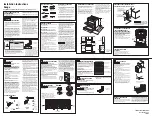
7
To Clean:
IMPORTANT: Before cleaning, make sure all controls are off and
the oven and cooktop are cool. Do not use oven cleaners, bleach
or rust removers.
1. Remove the burner cap from the burner base and clean
according to “General Cleaning” section.
2. Clean the gas tube opening with a damp cloth.
3. Clean clogged burner ports with a straight pin as shown. Do
not enlarge or distort the port. Do not use a wooden
toothpick. If the burner needs to be adjusted, contact a
trained repair specialist.
4. Replace the burner cap, making sure the alignment pins are
properly aligned with the burner cap.
5. Turn on the burner. If the burner does not light, check cap
alignment. If the burner still does not light, do not service the
sealed burner yourself. Contact a trained repair specialist.
Burner Rotation
The right side burners can be rotated 180° to reduce the distance
between the front and back burners. This permits better heat
distribution when using oblong pans or griddles.
To Rotate Burners:
1. Make sure burners are cool before beginning rotation.
2. Remove right side grates and burner caps.
3. Lift burners from cooktop, as shown.
4. Rotate burners 180°, as shown.
5. Replace burners, with large hole over gas tube opening, and
small hole over the ignitor. See “Sealed Surface Burners”
section for burner parts descriptions. Push burner down,
flush with cooktop.
6. Replace burner caps and grates.
Home Canning
When canning for long periods, alternate the use of surface
cooking areas, elements or surface burners between batches.
This allows time for the most recently used areas to cool.
■
Center the canner on the grate or largest surface cooking
area or element. Canners should not extend more than 1 in.
(2.5 cm) outside the cooking area.
■
Do not place canner on two surface cooking areas, elements
or surface burners at the same time.
■
On ceramic glass models, only use flat-bottomed canners.
■
On coil element models, the installation of a Canning Unit Kit
is recommended. If not installed, the life of the coil element
will be shortened. See “Assistance or Service” for ordering
instructions.
■
For more information, contact your local U.S. Government
Agricultural Department Extension Office. In Canada, contact
Agriculture Canada. Companies that manufacture home
canning products can also offer assistance.
Cookware
IMPORTANT: Never leave empty cookware on a hot surface
cooking area, element or surface burner.
Ideal cookware should have a flat bottom, straight sides, a well-
fitting lid and the material should be of medium-to-heavy
thickness.
Rough finishes may scratch the cooktop. Aluminum and copper
may be used as a core or base in cookware. However, when used
as a base it can leave permanent marks on the cooktop or grates.
Cookware material is a factor in how quickly and evenly heat is
transferred, which affects cooking results. A non-stick finish has
the same characteristics as its base material. For example,
aluminum cookware with a non-stick finish will take on the
properties of aluminum.
1. Incorrect
2. Correct
1
2








































